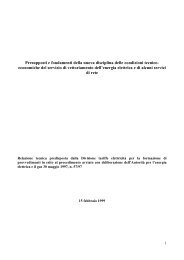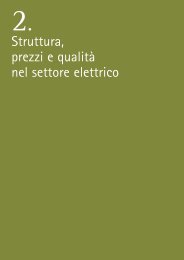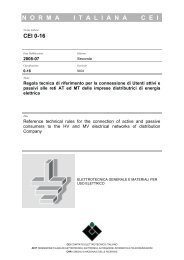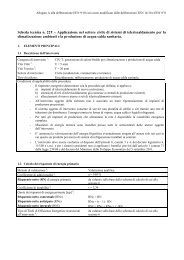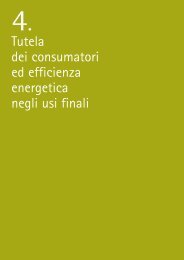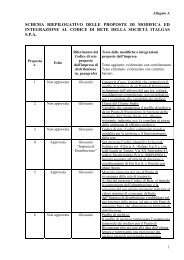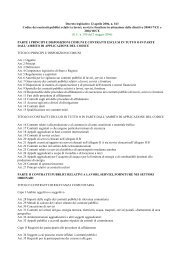Third Benchmarking Report on Quality of Electricity Supply
Third Benchmarking Report on Quality of Electricity Supply
Third Benchmarking Report on Quality of Electricity Supply
- No tags were found...
You also want an ePaper? Increase the reach of your titles
YUMPU automatically turns print PDFs into web optimized ePapers that Google loves.
1.5 Assumpti<strong>on</strong>s for benchmarking <strong>of</strong> actual levels <strong>of</strong> c<strong>on</strong>tinuity <strong>of</strong> supplyBecause <strong>of</strong> different measurement practices in European countries, available data <strong>on</strong> actual levels<strong>of</strong> c<strong>on</strong>tinuity <strong>of</strong> supply are not always comparable. It is important to c<strong>on</strong>sider the country specificc<strong>on</strong>diti<strong>on</strong>s detailed in the Annex to this chapter. In particular the following should be noted:· First, whilst the scope <strong>of</strong> benchmarking interrupti<strong>on</strong>s has been extended to include short interrupti<strong>on</strong>sas well as l<strong>on</strong>g interrupti<strong>on</strong>s, not all countries separate their interrupti<strong>on</strong>s data intothese two categories.· Sec<strong>on</strong>d, there are different ways <strong>of</strong> measuring supply interrupti<strong>on</strong>s. C<strong>on</strong>tinuity data may becollected at all voltage levels or may exclude some voltage levels, this will be identified laterin the report. Furthermore, c<strong>on</strong>tinuity indicators may refer to all customers or be split betweencustomers at different voltage levels.· The final and perhaps most important factor to take into c<strong>on</strong>siderati<strong>on</strong> is that c<strong>on</strong>tinuity indicatorsare not always defined in a comparable way. C<strong>on</strong>tinuity indicators can be weighted bythree different methods; by customer, transformer or c<strong>on</strong>tracted power. This can give rise todifferences depending <strong>on</strong> which weighting method is used.Measurement practices have an important role in the definiti<strong>on</strong> <strong>of</strong> standards and in the design <strong>of</strong>incentive/penalty regimes. The relati<strong>on</strong>ship between c<strong>on</strong>tinuity measurement systems and standardsand/or incentive/penalty regimes will be discussed in depth.This secti<strong>on</strong> c<strong>on</strong>tains comparative informati<strong>on</strong> about: the type <strong>of</strong> interrupti<strong>on</strong>s m<strong>on</strong>itored, the statisticalindicators calculated, the guidance rules for recording interrupti<strong>on</strong>s and the technologyinvolved, as well as the audit procedures.1.5.1 Interrupti<strong>on</strong> m<strong>on</strong>itoring and communicati<strong>on</strong>With very few excepti<strong>on</strong>s, all the surveyed regulators m<strong>on</strong>itor l<strong>on</strong>g (>3’) planned and unplanned interrupti<strong>on</strong>s arisingfrom distributi<strong>on</strong>. Interrupti<strong>on</strong>s at the distributi<strong>on</strong> level are not currently m<strong>on</strong>itored in Poland. In Slovenia some dataare available, however, the recording is not yet systematic. In Latvia no distincti<strong>on</strong> is made between planned andunplanned interrupti<strong>on</strong>s. In Ireland no distincti<strong>on</strong> is made between short and l<strong>on</strong>g interrupti<strong>on</strong>s (all interrupti<strong>on</strong>s l<strong>on</strong>gerthan 1 minute are registered).It is clear from the survey that significant differences exist with regard to accuracy, as well as completeness in themeasurement and registrati<strong>on</strong> <strong>of</strong> the data. In additi<strong>on</strong>, m<strong>on</strong>itoring <strong>of</strong> c<strong>on</strong>tinuity data by the regulators is a fairly recentactivity for numerous countries. Robust data would require at least three years <strong>of</strong> historical measurements, c<strong>on</strong>sistentwith unambiguous recording rules. C<strong>on</strong>sequently, even if most <strong>of</strong> the regulators indicated in the questi<strong>on</strong>naire thatthey register l<strong>on</strong>g interrupti<strong>on</strong>s, fewer countries met the requirements chosen for inclusi<strong>on</strong> in the data comparis<strong>on</strong>.Only a restricted number <strong>of</strong> countries register interrupti<strong>on</strong>s originating from all voltage levels, HV (high voltage), MV(medium voltage), and LV (low voltage) 9 (Czech Republic, Finland, France, Greece, Great Britain, Hungary, Italy,Lithuania, Norway, Portugal, and Sweden). In most cases recording is limited to HV and/or HV and MV (Austria,Est<strong>on</strong>ia, Ireland, Latvia, Slovenia, and Spain). In this case, the number and durati<strong>on</strong> <strong>of</strong> interrupti<strong>on</strong>s actuallyexperienced by c<strong>on</strong>sumers will be higher than indicated (interrupti<strong>on</strong>s with origin <strong>on</strong> the LV network are not registered).In Belgium (Wall<strong>on</strong>ia) interrupti<strong>on</strong> data are divided between HV and LV, but LV interrupti<strong>on</strong>s are recorded <strong>on</strong>lyif l<strong>on</strong>ger than 15 minutes. A number <strong>of</strong> m<strong>on</strong>itoring systems are under development.9Generally LV means below 1 kV, MV means between 1 and 35 (or 60) kV and for this report HV includes those voltages thatare generally referred to as EHV. Voltage levels are not the same in all EU countries.7<str<strong>on</strong>g>Third</str<strong>on</strong>g> <str<strong>on</strong>g>Benchmarking</str<strong>on</strong>g> <str<strong>on</strong>g>Report</str<strong>on</strong>g> <strong>on</strong> <strong>Quality</strong> <strong>of</strong> <strong>Electricity</strong> <strong>Supply</strong> – 2005 · Chapter 1





